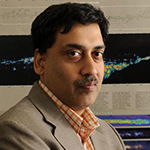Seminars are held at 4:00 PM on Tuesdays in Room F160
on the first floor of the Technological Institute (2145 Sheridan Road) unless otherwise noted
Spring Quarter 2010
| Date | Visitor / Seminar | Host | |
| March 30 |  |
Luis Reyes The field of high-energy astrophysics is experiencing a revolution due to recent observations that have revealed a universe that is surprisingly rich, variable and complex at gamma-ray energies. This revolution has now switched into high gear with the launch of the Fermi Gamma-ray Space Telescope and the full-fledged operation of a new generation of ground-based instruments such as VERITAS, H.E.S.S. and MAGIC. Among the different classes of gamma-ray sources observed by these instruments, a particular subset of active galactic nuclei (AGN) known as blazars stand out as some of the most energetic and variable objects observed at any wavelength. In my talk I will describe how the complementary capabilities of space and ground-based instruments are leading us to a better understanding of gamma-ray blazars as high-energy sources, as a population, and as a cosmological tool to probe the background radiation known as extragalactic background light (EBL). Finally, I will discuss the important scientific return that a next-generation instrument such as AGIS would bring to the field of AGN astrophysics. | Smadar Naoz |
| April 6 |
 |
Sebastian Heinz We have known about the large scale impact of jets from supermassive black holes for decades and have successfully used knowledge gained from the kpc scale radio structures they inflate to study black hole growth and jet formation. In recent years, it has become increasingly clear that stellar mass black holes in X-ray binaries do exactly the same tricks their supermassive cousins do: They produce powerful jets that interact with the ISM, inflating bubbles, producing shocks, and leaving behind cosmic ray laced, magnetized exhaust. I will discuss how we can use this exhaust to constrain important aspects of accretion and jet physics. |
Ron Taam |
| April 13 |
 |
Elena D'Onghia The most dark matter dominated galaxies known are the dwarf spheroidals, but their origin is still uncertain. The recent discovery of ultra-faint dwarf spheroidals around the Milky Way further challenges our understanding of how low-luminosity galaxies originate and evolve because of their even more extreme paucity of gas and stars relative to their dark matter content. By employing numerical simulations we propose that interactions between dwarf disc galaxies can excite a gravitational resonance that immediately drives their evolution into spheroidals. This effect, which is purely gravitational in nature, is distinct from other mechanisms which have been proposed up to now to explain the origin of dwarf spheroidals, such as merging, galaxy-galaxy harassment and more general heating processes, or tidal and ram pressure stripping. Using a new analytic formalism that we named "quasi-resonant theory of tidal interactions" I will show the efficiency and nature of this process and its applicability to a huge number of problems: from the formation of star tails in galaxies to planetary systems. |
Loren Hoffman |
| April 20 |
Dawn Erb A large fraction of the stars in the universe today formed during the redshift interval 1.5 <z<3, when the universe was only about 25% of its current age. However, the quantitative study of galaxies in this redshift range from large spectroscopic samples has only recently become feasible. Such spectra offer a unique opportunity to quantify the physical conditions in these distant galaxies and their interactions with the surrounding intergalactic gas. I will discuss the results from rest-frame UV and optical spectra of star-forming galaxies at z~2, highlighting the galaxies kinematics, elemental abundances, large-scale outflows and inflows of gas, and what unusual galaxies at z~2 may tell us about galaxies even earlier in the universe. | Dave Meyer | |
| April 27 |  |
Elena Rasia In the next few years large sky surveys will be underway with the aim of identifying and characterizing galaxy clusters over large portions of the sky. The astronomical community will deal with tens of thousands of clusters observed in the optical (e.g., with the DES survey), millimetric (e.g., with the South Pole Telescope survey) or X-rays (e.g., with the e-Rosita mission). With this ambitious and promising expectation in mind, now is the right time to investigate the systematics that could affect the analysis of real data and provide a concrete framework for the statistical studies that will be performed. To address questions both in cosmology and in smaller-scale astrophysics, we are deciphering the various connections among observable cluster properties, the intrinsic quantities and the underlying mass distribution including the evolution with redshift.
|
Fred Rasio |
| May 4 |  |
Andy Fruchter Gamma-Ray Bursts are explosions of nearly unrivalled brilliance. They can be bright enough to be seen at cosmological distances with the naked eye and can appear to emit the energy of the rest mass of the sun in high-energy photons in a matter of seconds. I will show evidence that most of these bursts, the so-called long, soft bursts, are produced by the collapse of extremely massive stars in star-forming galaxies which tend to resemble the Magellanic clouds far more than our own Milky Way. The astrophysical origin of a smaller subset of bursts, the short, hard bursts, remains a mystery, though these seem to be distributed much more like the general population of stars in the local universe. Even if uncertainties surrounding their formation and emission mechanisms remain, both types of bursts may prove useful cosmological probes in the years ahead. |
Vicky Kalogera |
| May 11 |  |
Fabian Heitsch Galactic star formation occurs at a surprisingly low rate. Yet, recent large-scale surveys of dark clouds in the Galaxy show that one rarely finds molecular clouds without young stellar objects. Thus, star formation must occur rapidly upon molecular cloud formation. I will argue that this rapid onset of star formation poses stringent constraints on the physical properties and on the boundary conditions of the parental molecular cloud, which in turn requires a closer study of the cloud formation process. I will discuss a series of numerical experiments on cloud formation, demonstrating that there is no need (and no way) for turbulent support, but that the observed turbulence in molecular clouds is a consequence of global gravitationally driven motions and of the cloud formation process itself. The role of the magnetic field seems to be in parts consistent with a classical picture of support, with the difference that it only plays a role in the diffuse molecular gas, but notin the dense filaments. I will discuss these findings in the context of recent observations. |
Giles Novak |
| May 18 |  |
Hagai Perets Some stars are found in the wrong place and/or at the wrong time. Apparently young stars, so called blue stragglers, are found in very old stellar clusters. The environment near the massive black hole (MBH) in the Galactic center is very hostile to star formation, yet newly formed stars are found very close to the MBH. The galactic halo is thought to be composed of very old stars, yet young stars are observed in such environment too. Similarly supernovae supposedly produced from the core collapse of massive young stars are found in galactic halos and in elliptical galaxies, where such young stars should not exist. In my talk I will discuss such "existential" paradoxes of youth and suggest (mostly) dynamical solutions which can explain the origin of such out of place/time stars. As I will show the solutions to these various puzzles could have important implications for our understanding of various issues, from missing components in current population synthesis studies, stellar dynamics in galactic nuclei and dense stellar systems, measuring the dark component of the galaxy and the chemical composition of the universe. |
Smadar Naoz |
| May 25 |  |
Elena Pierpaoli USC CANCELED |
Mel Ulmer |
| June 1 |  |
Vikram Dwarkadasl Core-collapse supernovae (SNe) arise from the explosion of massive stars. The resultant shock wave will expand in the circumstellar medium formed by mass-loss from the massive star. The interaction of the shock wave with this medium gives rise to X-ray and radio emission. Analysis of the emission can provide significant clues to the density structure of the ambient medium. That can be used to obtain information about the mass-loss properties of the star, especially in the final 1% of the star's lifetime, and from thence about the progenitor itself. This is probably the only method to investigate with reasonable accuracy the progenitor properties when the star itself is no longer around.
|
Farhad Zadeh Ron Taam |
Past Astrophysics Seminars